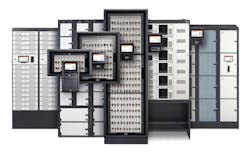The Growing Interest in Integrations: How Key & Asset Management Are Representative of a Shift in Data Center Operations
The future of data center operations isn’t seen through a crystal ball, but rather a single pane of glass. Operators are trending towards a fully integrated environment where all security systems are connected and optimized through the main access control system - one system to rule them all. As such, operators should prioritize solutions that can be easily integrated, rather than utilizing separate solutions and training employees on multiple platforms. There are several practical examples that illustrate how this can be accomplished effectively.
It's imperative that data center operators prioritize security, especially given the rapid expansion of data center construction. Security and access control need to be fundamental elements in planning for operations, and by doing so at the onset, operators are establishing a framework in which all solutions can be connected. For many, that includes some measure of physical key management. Whether as a primary or redundant access control measure, physical keys play a critical role in maintaining operations and ensuring secure access to authorized users. It’s therefore important to have appropriate key management solutions in place to properly manage their usage. Intelligent key cabinets can be integrated into almost any access control system, so that employees can use their same access credential for the cabinet that they do for general access to the building. Similarly, if an employee is terminated, his or her access to all buildings and cabinets can be deactivated simultaneously. All key transactions are monitored and recorded, producing an audit trail that can be leveraged for compliance purposes. Different levels of access can be assigned to certain keys, like those to a server rack, so that only authorized personnel can remove them. If a key isn’t returned by a certain time, a manager can be notified, which cuts down on the downtime spent looking for it. This saves operators time and money, including from having to re-key a facility if a key is lost.
Because many data center facilities include multiple buildings across a campus, it’s important for operators to think strategically about how workflows are synced between all facilities. Regarding key management, multiple cabinets can be leveraged in specific areas to avoid having employees walk to another building simply to remove a key, and cabinets that are closer to their operations help employees return to their tasks faster. As mentioned above, all key transactions, no matter how many cabinets are installed, can be monitored from a single point of view, which helps operators see comprehensively who has which key and when and where it was taken.
Data centers often require additional, supplemental technology for employees to accomplish their tasks, including shared assets like radios, tablets and laptops. The management of these devices is often equally as important as that of physical keys, as they can contain highly sensitive data. If those devices end up in the wrong person’s hands, the consequences could be disastrous. Like key cabinets, intelligent asset management lockers, which also integrate into the central access control system, are a useful tool for operators to safeguard their employees’ critical assets. Each device is RFID-tagged and placed in a separate compartment in the locker, which is only accessible by authorized users. Assets are charged inside the locker, and when a user goes to check one of them out, the system prioritizes which asset has been charging the longest. This helps eliminate the possibility of an employee unknowingly checking out a dead asset. If there’s anything wrong with that device, the employee inputs it in the locker interface, which removes the device from circulation until the fault has been corrected. This extends the life of all the shared assets by ensuring equal and proper usage, which ultimately can save operators money.
Both intelligent lockers and cabinets are scalable solutions that can be expanded based on user needs and increased data center operations. Managers can consider implementing them in a phased approach and see how one solution impacts a particular sector of the facility before fully adopting it across all departments. That’s the value of intelligent solutions – they can serve as an internal case study of how efficient operations can be. Once there’s buy-in within one sector, they can be scaled, and the benefits experienced by the end-user can grow exponentially. Data centers are the perfect example of facilities that need flexible, scalable solutions that integrate within a central access control system. As shown above, intelligent key cabinets and asset management lockers are two instances of modern technology that will continue to grow in utilization within data centers because of their clear return on investment.
About the Author

Craig Newell
Craig Newell is the Vice President of Sales & Business Development for Traka, where he has worked for nearly 30 years in production, service, R&D, operations and sales.
Traka is part of ASSA ABLOY Global Solutions, which provides safe and sustainable cutting-edge technology solutions for physical and digital access management control. Traka is the global leader in intelligent management solutions for keys and equipment. Their solutions help organizations better control their important assets, improve productivity and accountability, and reduce risk in critical processes. To learn more, click here.



